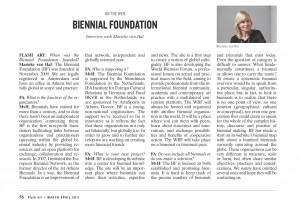FLASH ART: When was the Biennial Foundation founded?
Marieke van Hal: The Biennial Foundation was founded in November 2009. We are legally registered in Amsterdam and have an office in Athens, but are fully global in scope and practice.
FA: What is the function of the organization?
MvH: Biennials have existed for more than a century, and to date there hasn’t been an independent organization connecting them. BF is the first non-profit foundation facilitating links between organizations and practitioners operating within the global biennial industry by providing resources and an open platform for exchange, collaboration and research. In 2007, I initiated the European Biennial Network, as the former director of the 1st Athens Biennale. In a way, Biennial Foundation is an improvement of that network, independent, and globally oriented now.
FA: Who is supporting it?
MvH: The Biennial Foundation is supported by Mondriaan Foundation in the Netherlands, IFA Institute for Foreign Cultural Relations in Germany, and Fund BKVB in the Netherlands, and we are sponsored by ArtnSports in Athens, Greece. BF is a young, non-national organization. The support we have received so far is innovative as it reflects the fact that these organizations not only act bi-laterally, but globally too. In order to grow and to further develop, we are working on creating more financial friends.
FA: What is your next project?
MvH: The Biennial Foundation is developing its website into a center for biennial knowledge. The site will be an important place where biennials can share their activities, expertise and news. The site is a first step to create a notion of global collegiality. BF is also developing the World Biennial Forum, a professional forum on actual and practical issues in the field, aiming to provide professionals from the international biennial community, academia, and contemporary art practice with a multilateral convention platform. The WBF will always be hosted and organized with another biennial organization in the world. It will be a place where you can meet with peers, learn about structures and innovations, and exchange possibilities and benefits of cooperative action. The WBF will take place on a biannual or triannual pace.
FA: Do you include all biennials or do you make a selection?
MvH: The BF is focused on both established and promising biennials. It is hard to keep track of the precise number of biennials and triennials that exist today. Even the question of category is difficult to answer: What fundamentally constitutes a biennial or allows one to carry the name? To create a systematic biennial overview would be to speak from a particular, singular, authoritative place; but, in fact, to look at biennials is to realize that there is no one point of view, no one position (geographical, cultural or conceptual), nor even one generation that could claim to speak for the whole of the complex history, discourse, and practice of biennial making. BF has made a start on its website’s biennial map with about a hundred biennials currently operating around the globe. These organizations can be very different in structure, scale or form, but often share similar objectives, practices and considerations. We surely have omitted several ones and hope they will be contacting us.


